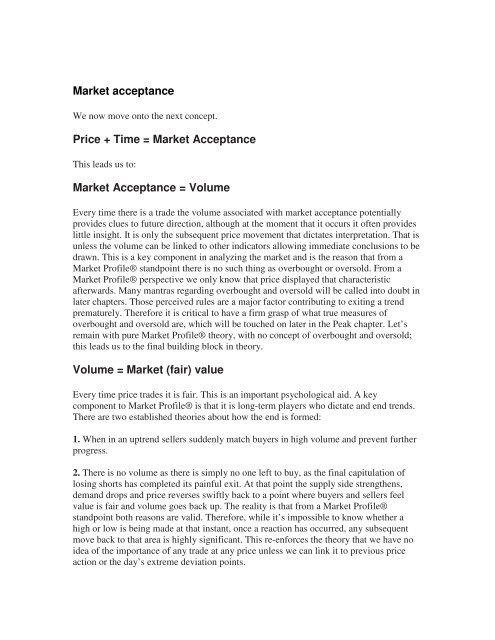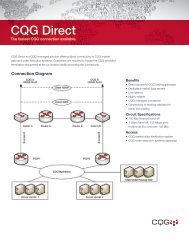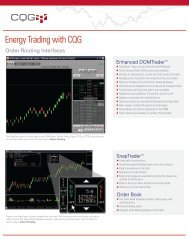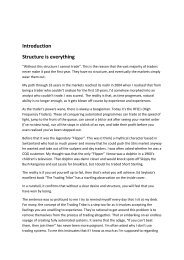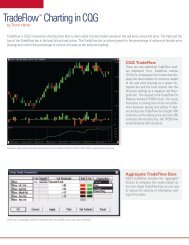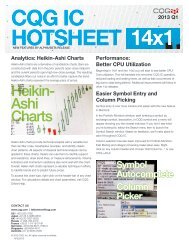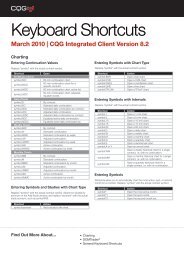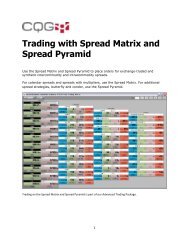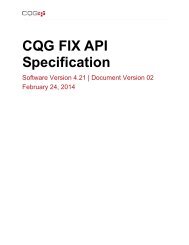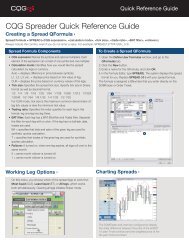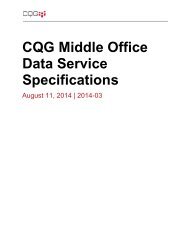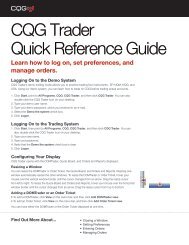Trading Time. - CQG.com
Trading Time. - CQG.com
Trading Time. - CQG.com
You also want an ePaper? Increase the reach of your titles
YUMPU automatically turns print PDFs into web optimized ePapers that Google loves.
Market acceptance<br />
We now move onto the next concept.<br />
Price + <strong>Time</strong> = Market Acceptance<br />
This leads us to:<br />
Market Acceptance = Volume<br />
Every time there is a trade the volume associated with market acceptance potentially<br />
provides clues to future direction, although at the moment that it occurs it often provides<br />
little insight. It is only the subsequent price movement that dictates interpretation. That is<br />
unless the volume can be linked to other indicators allowing immediate conclusions to be<br />
drawn. This is a key <strong>com</strong>ponent in analyzing the market and is the reason that from a<br />
Market Profile® standpoint there is no such thing as overbought or oversold. From a<br />
Market Profile® perspective we only know that price displayed that characteristic<br />
afterwards. Many mantras regarding overbought and oversold will be called into doubt in<br />
later chapters. Those perceived rules are a major factor contributing to exiting a trend<br />
prematurely. Therefore it is critical to have a firm grasp of what true measures of<br />
overbought and oversold are, which will be touched on later in the Peak chapter. Let’s<br />
remain with pure Market Profile® theory, with no concept of overbought and oversold;<br />
this leads us to the final building block in theory.<br />
Volume = Market (fair) value<br />
Every time price trades it is fair. This is an important psychological aid. A key<br />
<strong>com</strong>ponent to Market Profile® is that it is long-term players who dictate and end trends.<br />
There are two established theories about how the end is formed:<br />
1. When in an uptrend sellers suddenly match buyers in high volume and prevent further<br />
progress.<br />
2. There is no volume as there is simply no one left to buy, as the final capitulation of<br />
losing shorts has <strong>com</strong>pleted its painful exit. At that point the supply side strengthens,<br />
demand drops and price reverses swiftly back to a point where buyers and sellers feel<br />
value is fair and volume goes back up. The reality is that from a Market Profile®<br />
standpoint both reasons are valid. Therefore, while it’s impossible to know whether a<br />
high or low is being made at that instant, once a reaction has occurred, any subsequent<br />
move back to that area is highly significant. This re-enforces the theory that we have no<br />
idea of the importance of any trade at any price unless we can link it to previous price<br />
action or the day’s extreme deviation points.


